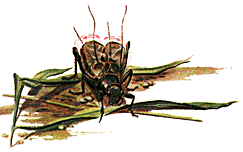


 Crickets are often kept as pets in Asian countries because their chirping is considered beautiful and soothing. It is said that they are also something of a burglar alarm. Once they are accustomed to members of the household, they will continue to chirp, stopping only when a stranger enters the room.
Crickets are often kept as pets in Asian countries because their chirping is considered beautiful and soothing. It is said that they are also something of a burglar alarm. Once they are accustomed to members of the household, they will continue to chirp, stopping only when a stranger enters the room.
Keeping crickets is a simple matter. Catching them can be more difficult. You want to catch common field crickets, Acheta assimilis , which are abundant across most of North America. If you live elsewhere in the world, your local garden variety cricket should do the trick. The males are the ones that sing. You can easily tell the difference due to the female's long egg laying "tail", or ovipositor, which they use to lay eggs under the surface of soil.
If you have difficulty locating wild crickets, you can try pet stores, which sell "feeder" crickets to people who keep pet reptiles. Also places selling fresh water fishing bait often sell crickets.
Never keep more than one male in the same cricket house. They are very territorial and will probably end up killing one another. You can keep a male and female(s) together. You can keep several females together, but they won't sing. The males sing (mostly at night) to attract the females and to scare off the other males.
A cricket house can be simple or elaborate. The crickets don't care, as long as they are properly cared for. The key to choosing or designing a cricket house is making it escape proof and fairly simple to clean. There are many beautiful cages made of closely spaced reed slats from China, as well as small carved, round wooden boxes, complete with ventilation holes, in which their owners carry prized crickets with them.
 A large jar can be used, covered with a piece of fine screening, cheesecloth, or similar, fixed with a rubber band. You can also construct something a bit more elaborate, such as the box pictured at left. A small piece of 1/4" plywood is the base. The size is not critical; this example is 4" x 5" (10 x 12 mm). Two more pieces of plywood are nailed on to form the sides. The front and back are pieces of glass, which can be taped on with plastic tape. The top is screen, cut to fit, which is also taped on. This basic design can be easily improved to make a longer lasting house with a lid that can be removed and replaced without having to reapply the tape each time.
A large jar can be used, covered with a piece of fine screening, cheesecloth, or similar, fixed with a rubber band. You can also construct something a bit more elaborate, such as the box pictured at left. A small piece of 1/4" plywood is the base. The size is not critical; this example is 4" x 5" (10 x 12 mm). Two more pieces of plywood are nailed on to form the sides. The front and back are pieces of glass, which can be taped on with plastic tape. The top is screen, cut to fit, which is also taped on. This basic design can be easily improved to make a longer lasting house with a lid that can be removed and replaced without having to reapply the tape each time.
To make the crickets really feel at home, spread a little sand in the bottom of the box or jar. Adding a rock gives the cricket a place to hide if he wants. A few leaves and small twigs are nice finishing touches for recreating a natural environment. Keep the cricket house in a cool, shady place inside, away from any direct sunlight. Every so often, sprinkle or mist the "ground " with a little water. A small piece of wet sponge or cotton ball will help maintain the correct humidity. Don't forget to change this every couple of days or so.
One cricket won't eat much, so try very small pieces of potato, carrot, apple, lettuce, and other fruits and vegetables (they usually don't like citrus), as well as fruit rinds and bits of bread. Experiment to see what your cricket will eat. Don't leave any uneaten food in the cricket house for more than a day or so as it will rot. You don't need to leave water for the cricket, as he will get all the moisture he needs from the fruit and vegetables.
Crickets tend to chirp faster in warmer weather. You can estimate what temperature it is by counting the chirps in 15 seconds and adding 40. This will give the approximate temperature in degrees Fahrenheit. It will work out the same if you count the chirps per minute, subtract 40, divide by 4, and add 50. Of course cricket chirping is affected by factors other than temperature, so this isn't always accurate.
Crickets chirp by rubbing their wings together, setting up vibrations from the subsonic to the ultrasonic. Barbara Webb, who does research in cricket hearing, points out that many species are specialized to hear the 4-7 kHz frequency that we enjoy. A cricket's ears are located on its front legs, visible as white spots.

This article was printed from the Bizarre Labs website at bizarrelabs.com